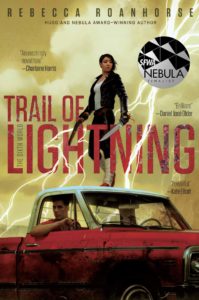 Trail of Lightning (2018)
Trail of Lightning (2018)
Written by: Rebecca Roanhorse
Genre: Urban Fantasy
Pages: 285 (Hardcover)
Series: The Sixth World Book #1
Publisher: Saga Press
Why I Chose It: I had the best of intentions to read Trail of Lightning last year for my resolution to read more diverse books. Rebecca Roanhorse is Ohkay Owingeh Pueblo/African American and she incorporates Native American mythology into the book. When I learned that Trail of Lightning had been nominated for the Nebula and Hugo Awards, I knew I had to read it.
The premise:
While most of the world has drowned beneath the sudden rising waters of a climate apocalypse, Dinétah (formerly the Navajo reservation) has been reborn. The gods and heroes of legend walk the land, but so do monsters.
Maggie Hoskie is a Dinétah monster hunter, a supernaturally gifted killer. When a small town needs help finding a missing girl, Maggie is their last best hope. But what Maggie uncovers about the monster is much more terrifying than anything she could imagine.
Maggie reluctantly enlists the aid of Kai Arviso, an unconventional medicine man, and together they travel the rez, unraveling clues from ancient legends, trading favors with tricksters, and battling dark witchcraft in a patchwork world of deteriorating technology.
As Maggie discovers the truth behind the killings, she will have to confront her past if she wants to survive.
Welcome to the Sixth World.
No Spoilers.
Discussion: The universe of Trail of Lightning is exquisite and unique. Climate change has drowned most of the United States in an event known as Big Water. Dinétah (the area where the Navajo tribe lived) has been protected from the outside world by magical walls but it is still a dangerous and chaotic place. Gods and monsters have come back into the world. It’s a universe where Coyote, the Trickster, might show up at your house and ask you to make him fry bread. Certain individuals can harness supernatural abilities, like healing and controlling the weather, through their clan powers.
The setting was my favorite part of the book. Roanhorse is a wonderfully descriptive writer who paints a vivid picture of crumbling towns, dodgy dive bars, and lonely deserts. Roanhorse describes the Wall that protects Dinétah: “…for every brick that was laid, a song was sung. Every lath, a blessing given. And the Wall took on a life of its own. When the workmen came back the next morning, it was already fifty feet high. In the east it grew as white shell. In the south, turquoise. The west, pearlescent curves of abalone, and the north, the blackest jet.” (p.23).
I only wish that the main characters were as fresh and original as Dinétah itself. Maggie, with her superhuman monster fighting skills and tragic past, is perilously close to being a cliché. At this point, I’d love to see an urban fantasy heroine who abhors violence and had a happy childhood. Kai, the sexy and supportive scholar who joins Maggie on her quest to kill monsters, also feels like a character I’ve met many times before. Several of the minor characters were more interesting, such as Tah, a medicine man and Maggie’s surrogate grandfather, and Grace, a widow who is raising kids and running an outlaw bar. I wondered what it would be like to explore Dinétah through their eyes. I would have also loved to have seen more of a perspective from Neizgháni, Maggie’s immortal monster-slaying mentor.
Roanhorse does an excellent job of weaving Native American mythology and culture into the story. I didn’t feel confused or bogged down with unnecessary details. I am an avid reader and I even resolved to read more diverse books last year, but I must confess that I haven’t read very much by Native American authors. It was refreshing to read a book that puts Native American characters and concerns front and center. Post-apocalyptic fiction has practically become its own genre, but in imaging the end of the world from the perspective of a marginalized people who have already experienced devastation, Roanhorse breathes new life into a familiar story. Maggie says, “But I had forgotten that the Diné had already suffered their apocalypse over a century before. This wasn’t our end. This was our rebirth.” (p. 23).
In conclusion: I regret not picking up Trail of Lightning sooner. The vivid writing, action-packed plot, and incorporation of Native American mythology make for a fun and novel reading experience. I’m looking forward to reading the second book in the series, Storm of Locusts, which is already out.

No Comments